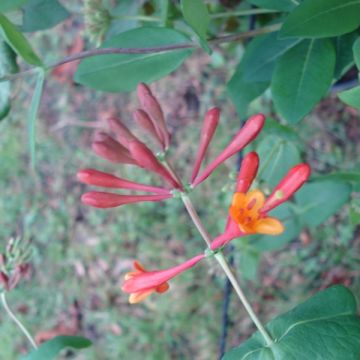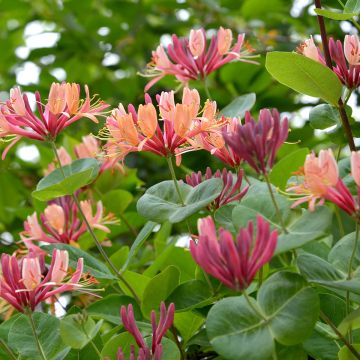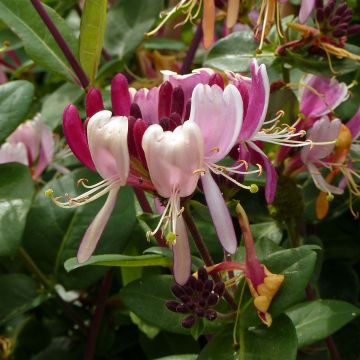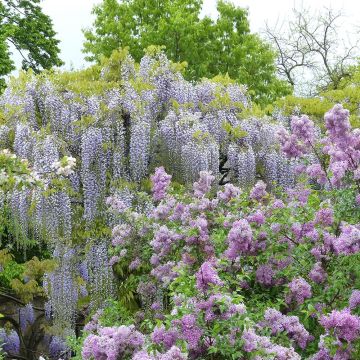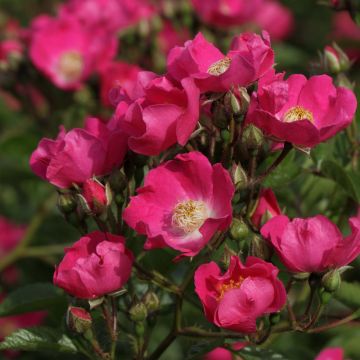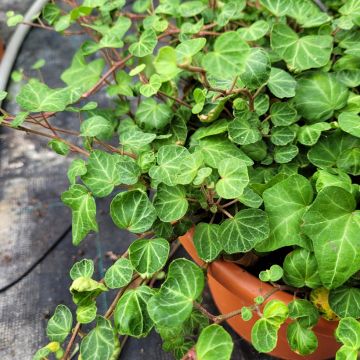

Lonicera japonica Sinensis - Chinese Honeysuckle
Lonicera japonica Sinensis - Chinese Honeysuckle
Lonicera japonica Sinensis
Japanese Honeysuckle, Hall's Honeysuckle, White Honeysuckle
This item cannot be shipped to the selected country
Delivery charge from €5.90
Delivery charge from €5.90
Delivery to Corse prohibited
More information
Schedule delivery date,
and select date in basket
This plant carries a 6 months recovery warranty
More information
We guarantee the quality of our plants for a full growing cycle, and will replace at our expense any plant that fails to recover under normal climatic and planting conditions.
From €5.90 for pickup delivery and €6.90 for home delivery
Express home delivery from €8.90.
From €5.90 for pickup delivery and €6.90 for home delivery
Express home delivery from €8.90.
Delivery to Corse prohibited: UE law prohibits the import of this plant from mainland France to Corse as part of the fight against Xylella fastidiosa. Please accept our sincere apologies.
More information
Does this plant fit my garden?
Set up your Plantfit profile →
Description
The Lonicera japonica Chinensis (sinensis) is a beautiful form with purple-tinged foliage of the famous Japanese honeysuckle, often planted in gardens in cold regions. This particularly vigorous climber, with significant growth, is interesting in slightly wild areas of the garden or to quickly cover a large wire fence. Its beautiful foliage, often evergreen, is adorned with beautiful purple shades, forming a superb backdrop for its long flowering, white with a hint of deep pink, and highly fragrant. It is also interesting for its ability to twine around very narrow supports, such as unsightly iron bars, pillars, or a clothesline post. Like clematis, this climbing plant requires little maintenance: it thrives with its head in the non-burning sun and its feet in the shade, in rather moist, ordinary soil.
The Japanese honeysuckle is a climbing and woody plant of the caprifoliaceae family, native to East Asia. In nature, this plant exhibits vigorous growth and rapid growth, making it suitable for larger, slightly wild spaces. The 'Chinensis' form is a beautiful mutation of this wild species. It is distinguished by its almost glabrous foliage, slightly purple. Its natural vigor, allowing it to produce branches over 10m (33ft) long, needs to be controlled. Its long stems twine around any supports they encounter, but can also crawl and form ground cover. They bear simple, ovate leaves arranged in an opposite pattern. From June onwards, a multitude of tubular flowers measuring 3-5 cm (1-2in) appear and continue until late summer. Divided into two lips, initially reddish-pink in buds, they open to reveal prominent stamens and a pastel throat: from cream-white, it turns cream-yellow when ripe. This highly fragrant flowering attracts many pollinating insects. It is followed by the formation of small, fleshy, black-violet berries, which are not edible.
This superb Japanese honeysuckle Sinensis is planted in the ground, away from harsh sunlight, in shaded areas. It is naturally perfect for covering anything that needs to be hidden: fences, wire mesh, or sheds, as long as it has a support. It is less known for its ability to twine around very narrow supports, transforming even the smallest pole into a vegetated column. It can also be allowed to spread on the ground, in a slightly wild area of the garden. It forms a beautiful combination with clematis. It also has a place in a hedge, alongside flowering shrubs such as lilacs, mock oranges, deutzias, or even arbustive ceanothuses. The evergreen foliage in a moderate to mild climate allows you to camouflage a wall or fence even in winter.
Report an error about the product description
Lonicera japonica Sinensis - Chinese Honeysuckle in pictures
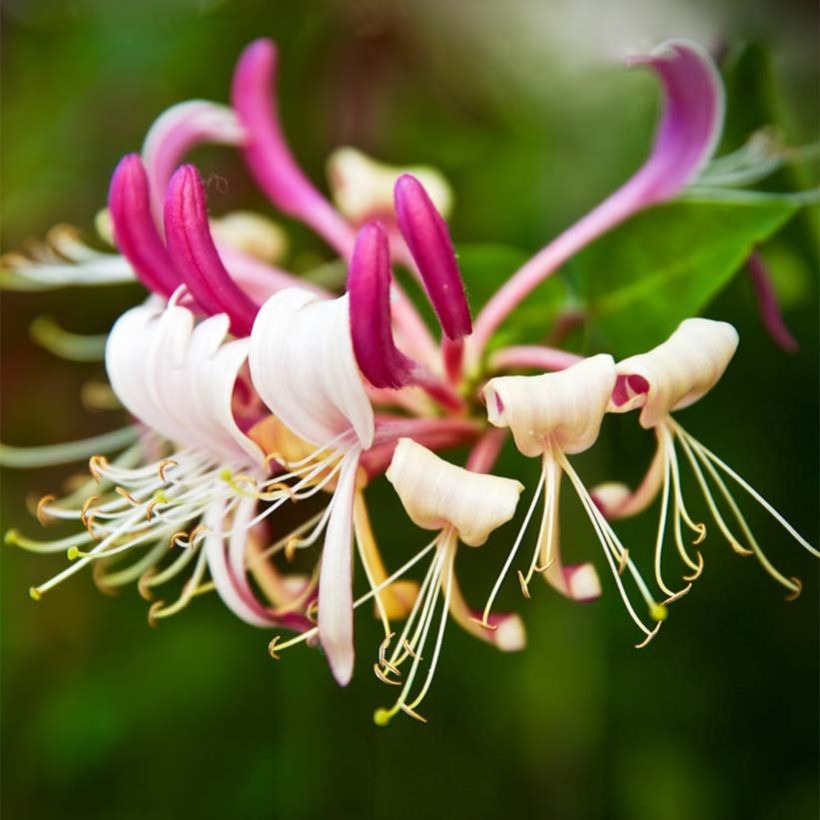



Plant habit
Flowering
Foliage
Botanical data
Lonicera
japonica
Sinensis
Caprifoliaceae
Japanese Honeysuckle, Hall's Honeysuckle, White Honeysuckle
Cultivar or hybrid
Other Honeysuckle
Planting and care
The Japanese honeysuckle Chinensis thrives in any good deep garden soil, slightly or not calcareous, rather rich and fresh. If the substrate tends to dry out, consider watering in the early summers or placing the plant in the shade. Mulch if necessary.
Prefer a sunny exposure to encourage flowering, but not scorching. A semi-shaded situation will also suit it, especially if the sun is intense in your region.
Prune each year for cleaning if you want to maintain an orderly shape. Do this in early winter so as not to compromise flowering, which occurs on the wood of the year. However, it is possible to severely cut back an older subject to completely renew the structure when it forms a thick tuft consisting in part of dead wood. This restoration can be done over one or two years.
Honeysuckles are hardy climbing plants ideal for quickly covering a wall or pergola. Provide them with support, they will attach themselves. We love them for their long flowering period and wonderful fragrance. Our advice: Install them near your terrace to fully enjoy their intoxicating scent, which intensifies in the morning and evening.
Planting period
Intended location
Care
-
, onOrder confirmed
Reply from on Promesse de fleurs
Foolproof climbers
Haven't found what you were looking for?
Hardiness is the lowest winter temperature a plant can endure without suffering serious damage or even dying. However, hardiness is affected by location (a sheltered area, such as a patio), protection (winter cover) and soil type (hardiness is improved by well-drained soil).

Photo Sharing Terms & Conditions
In order to encourage gardeners to interact and share their experiences, Promesse de fleurs offers various media enabling content to be uploaded onto its Site - in particular via the ‘Photo sharing’ module.
The User agrees to refrain from:
- Posting any content that is illegal, prejudicial, insulting, racist, inciteful to hatred, revisionist, contrary to public decency, that infringes on privacy or on the privacy rights of third parties, in particular the publicity rights of persons and goods, intellectual property rights, or the right to privacy.
- Submitting content on behalf of a third party;
- Impersonate the identity of a third party and/or publish any personal information about a third party;
In general, the User undertakes to refrain from any unethical behaviour.
All Content (in particular text, comments, files, images, photos, videos, creative works, etc.), which may be subject to property or intellectual property rights, image or other private rights, shall remain the property of the User, subject to the limited rights granted by the terms of the licence granted by Promesse de fleurs as stated below. Users are at liberty to publish or not to publish such Content on the Site, notably via the ‘Photo Sharing’ facility, and accept that this Content shall be made public and freely accessible, notably on the Internet.
Users further acknowledge, undertake to have ,and guarantee that they hold all necessary rights and permissions to publish such material on the Site, in particular with regard to the legislation in force pertaining to any privacy, property, intellectual property, image, or contractual rights, or rights of any other nature. By publishing such Content on the Site, Users acknowledge accepting full liability as publishers of the Content within the meaning of the law, and grant Promesse de fleurs, free of charge, an inclusive, worldwide licence for the said Content for the entire duration of its publication, including all reproduction, representation, up/downloading, displaying, performing, transmission, and storage rights.
Users also grant permission for their name to be linked to the Content and accept that this link may not always be made available.
By engaging in posting material, Users consent to their Content becoming automatically accessible on the Internet, in particular on other sites and/or blogs and/or web pages of the Promesse de fleurs site, including in particular social pages and the Promesse de fleurs catalogue.
Users may secure the removal of entrusted content free of charge by issuing a simple request via our contact form.
The flowering period indicated on our website applies to countries and regions located in USDA zone 8 (France, the United Kingdom, Ireland, the Netherlands, etc.)
It will vary according to where you live:
- In zones 9 to 10 (Italy, Spain, Greece, etc.), flowering will occur about 2 to 4 weeks earlier.
- In zones 6 to 7 (Germany, Poland, Slovenia, and lower mountainous regions), flowering will be delayed by 2 to 3 weeks.
- In zone 5 (Central Europe, Scandinavia), blooming will be delayed by 3 to 5 weeks.
In temperate climates, pruning of spring-flowering shrubs (forsythia, spireas, etc.) should be done just after flowering.
Pruning of summer-flowering shrubs (Indian Lilac, Perovskia, etc.) can be done in winter or spring.
In cold regions as well as with frost-sensitive plants, avoid pruning too early when severe frosts may still occur.
The planting period indicated on our website applies to countries and regions located in USDA zone 8 (France, United Kingdom, Ireland, Netherlands).
It will vary according to where you live:
- In Mediterranean zones (Marseille, Madrid, Milan, etc.), autumn and winter are the best planting periods.
- In continental zones (Strasbourg, Munich, Vienna, etc.), delay planting by 2 to 3 weeks in spring and bring it forward by 2 to 4 weeks in autumn.
- In mountainous regions (the Alps, Pyrenees, Carpathians, etc.), it is best to plant in late spring (May-June) or late summer (August-September).
The harvesting period indicated on our website applies to countries and regions in USDA zone 8 (France, England, Ireland, the Netherlands).
In colder areas (Scandinavia, Poland, Austria...) fruit and vegetable harvests are likely to be delayed by 3-4 weeks.
In warmer areas (Italy, Spain, Greece, etc.), harvesting will probably take place earlier, depending on weather conditions.
The sowing periods indicated on our website apply to countries and regions within USDA Zone 8 (France, UK, Ireland, Netherlands).
In colder areas (Scandinavia, Poland, Austria...), delay any outdoor sowing by 3-4 weeks, or sow under glass.
In warmer climes (Italy, Spain, Greece, etc.), bring outdoor sowing forward by a few weeks.

































